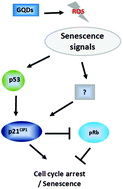Hydroxylated-graphene quantum dots induce cells senescence in both p53-dependent and -independent manner
Abstract
The numerous particular chemical/physical properties make graphene quantum dots (GQDs) attractive for various biomedical applications such as drug delivery, bioimaging and tumor photodynamic therapy (PDT). In the present study, the critical roles of hydroxyl-modified GQDs (OH-GQDs) on lung carcinoma A549 (wild type p53) and H1299 (p53-null) cells were investigated. Our data showed that a medium concentration (50 μg mL−1) of OH-GQDs significantly decreased the viability of A549 and H1299 cells. OH-GQDs treatment enhanced intracellular reactive oxygen species (ROS) generation. Furthermore, we found that treatment with ROS scavenger N-acetylcysteine (NAC) at least partially abolished the cytotoxic effect of OH-GQDs on A549 and H1299 cells. Hydroxylated GQDs lead to G0–G1 arrest and cells senescence. Signal pathway analysis revealed that OH-GQDs activated the expression of p21 in both a p53-dependent and -independent manner. Consistent with this, OH-GQDs could also inhibit the phosphorylation of Rb in both A549 and H1299 cells. These findings provide valuable information for the consideration of biomedical application of GQDs in the future.


 Please wait while we load your content...
Please wait while we load your content...